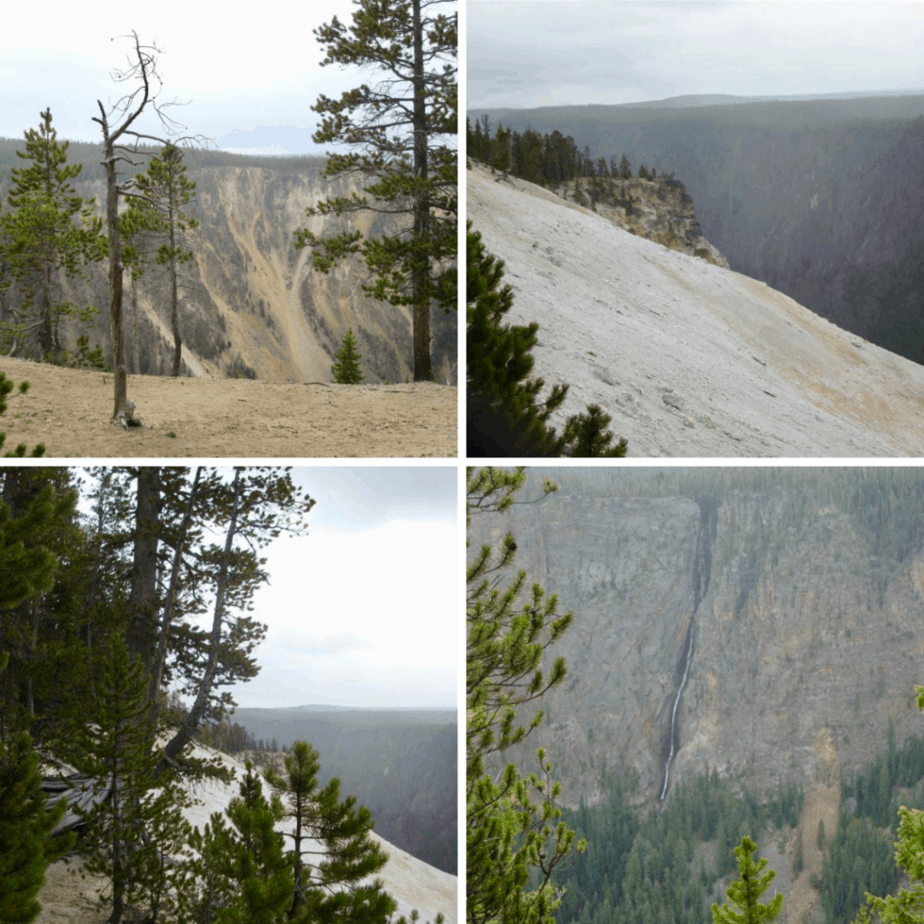
We left our car at the pullout, walked past the bungalow-sized glacial boulder, and started down an easy path. Short, flat, and offering a good view, the Cascade Overlook Trail promised to be a good wakeup hike. Enveloped in a thick evergreen wood, we relished the rhythm of quiet conversation and companionable silence mingled with the crunching rock under our feet and the rustling trees above our heads. Before long, the trail emerged from the trees, and there was the Grand Canyon, not of Arizona but of the Yellowstone River. We took careful steps along the curving rim of the chasm—one side of the way shaded and sheltered by a towering lodgepole wall and the other exposed, a fence of pines twisted and stunted by exposure.
With no official marker to announce our arrival, we knew we’d reached our destination when we found a break in the green on the far side of the gorge, an opening for the twelve-hundred-foot ribbon that is Silver Cord Falls. We perched on a log and enjoyed what we’d come for: the silence of the forest, the scent of pine, and the view of the canyon’s watercolor walls smudged with evergreen, sky, and a band of anchoring blue below.
It was on the return trip that I noticed it, a nagging ache in my calf muscles. They were tight and tired and it boded badly over our hiking plans for the rest of the day. When we stopped so I could stretch, I saw the that the ground we’d just covered wasn’t flat. We were at the top of a hill. Thinking back, I realized it wasn’t the first. Not the first up. Not the first down. We’d been ascending and descending slopes of varying degrees of steepness all along the way.
They were short. Easy. They hadn’t registered.

That was the problem.
Individually, none were hard to traverse. Together, though, they wore on my calf muscles. Not because they are especially weak, but because they are the wrong ones for the terrain.
Calf muscles do great work on flat surfaces but they aren’t meant to carry us uphill. That is for the quads. I know this. I learned it in hiking class. But the changes in terrain had been subtle and continual. I wasn’t paying attention.
If I had been, I’d have been walking differently. Because there’s a technique for hiking uphill: approach it like a set of stairs. Lift one foot, propel it forward, set it down, and lift the body with the quads. Lift the other foot, propel it forward, set it down, and lift the body with the quads. Repeat until you reach the top. The quads might burn a little, but they won’t tire out and tighten up as quickly as the calves. They’re strong. They’re made to bear the burden of lifting.
It’s not hard to use the right technique and, therefore, the right muscles. It is, in fact, easier. What’s hard is attending to the terrain closely enough that the subtleties of the landscape register. Without close attention, I don’t think about how I need to walk. I just walk. On auto-pilot.
Auto-pilot doesn’t work well on the trail. And it doesn’t work well when we’re navigating life by faith.
We walk by faith, not by sight—by what we believe about God and what we know to be true, not by what our senses say and how we feel. But we’re visual and we tend to focus on the seeing—or the not seeing—and forget that life unfolds in a landscape, in a topography that changes. We neglect to match our steps the terrain.
Here’s the truth: I prefer flat trails—easy ones with damp, mossy dirt just barely dappled by the sun. That kind of terrain is as rare in life as it is in the mountains. But here’s what the trail is teaching me about living: Even paths that seem flat, the ones not obviously riddled with steep ascents and descents, have subtle slopes along the way. Individually, they aren’t hard to traverse. Collectively, though, they wear on my heart, my soul, my mind, and my strength. Especially if I’m not paying attention, if I’m just moving along on autopilot, walking up and down slope after slope, not bothering to use the right muscles.
When it comes to spiritual muscle it isn’t only a matter of which ones to use, it’s a question of whose. Because it isn’t that the heart, soul, mind, and body are especially weak, it’s that they’re made to rely on another’s strength. God’s strength is made perfect in our weakness. The muscle we have was created to be supported and complemented by the strength He provides. I know this. Sometimes I remember. Sometimes I forget. This is why attention and awareness—especially in this age of distraction—are more than valuable spiritual disciplines.
They are survival skills.
Because we’re always walking. We’re always navigating—heading to a destination, not just through the details of the day. While some of the circumstances that make up the landscape of life are outside our control, how we travel through them is not. Attentive to the terrain and aware of our weakness, we’ll arrive at our journey’s end, one step at a time.
Ponder your path: What terrain are you traveling through these days? Are you calling on the right muscles?